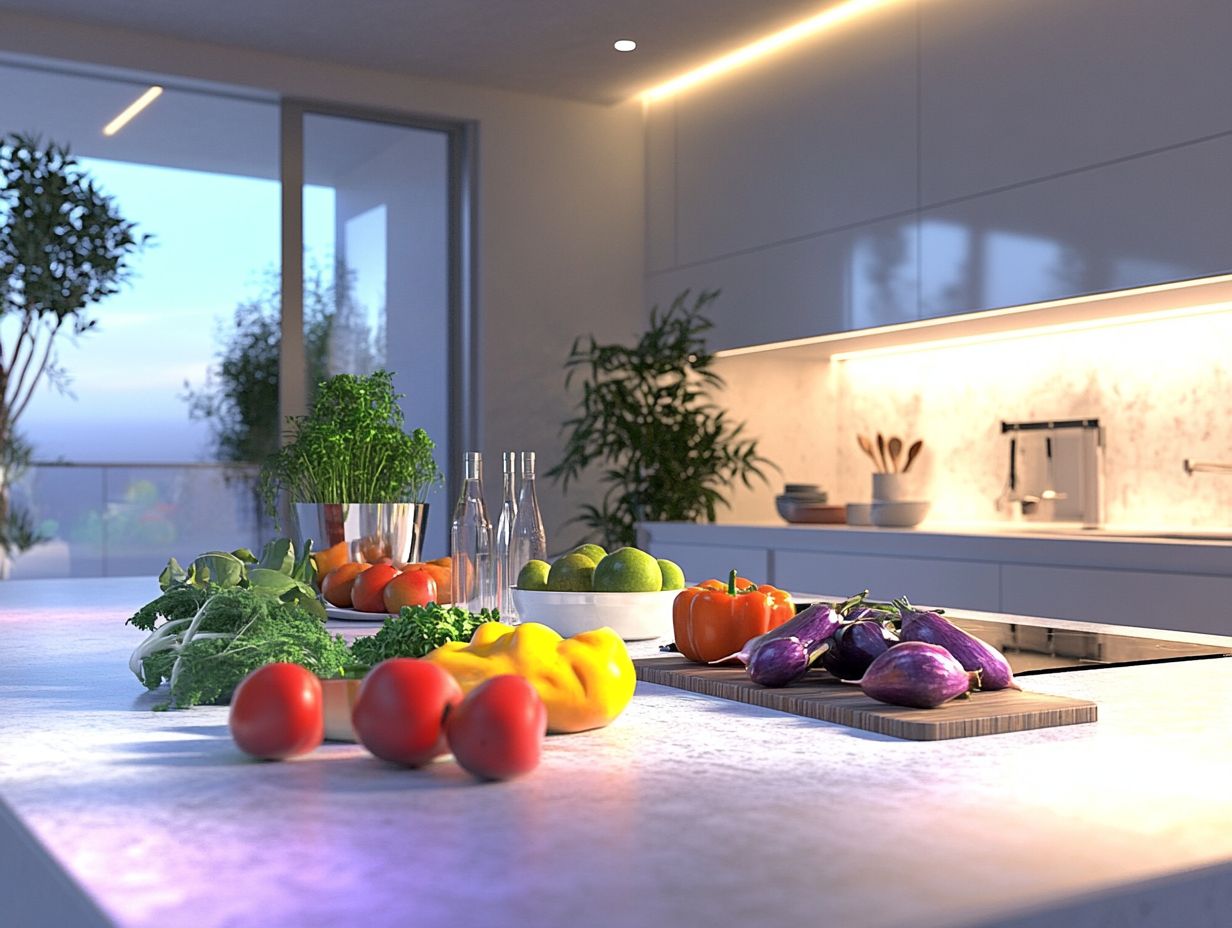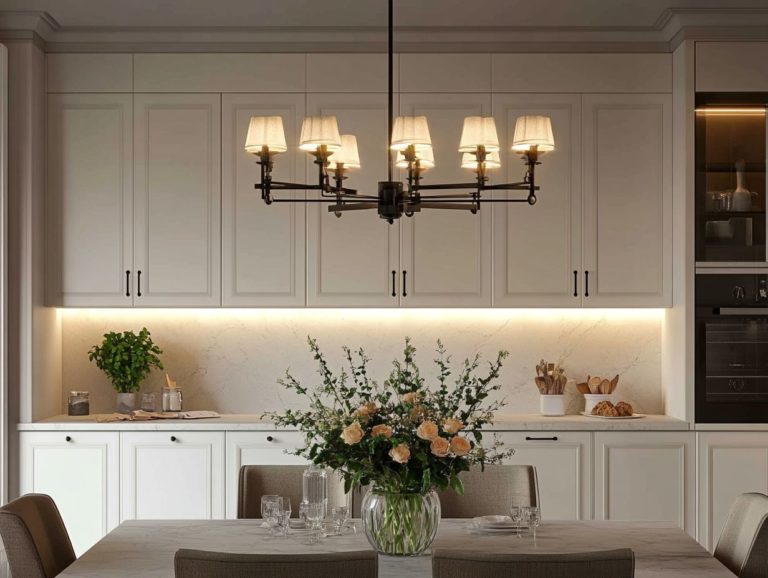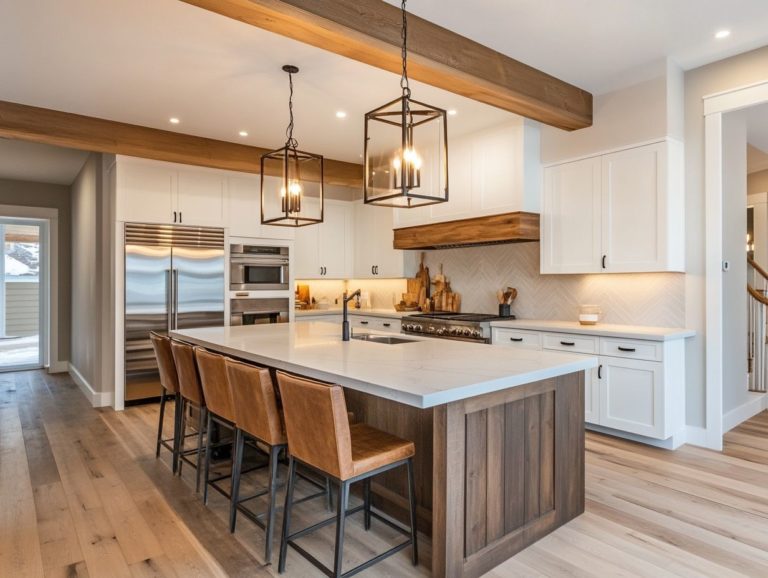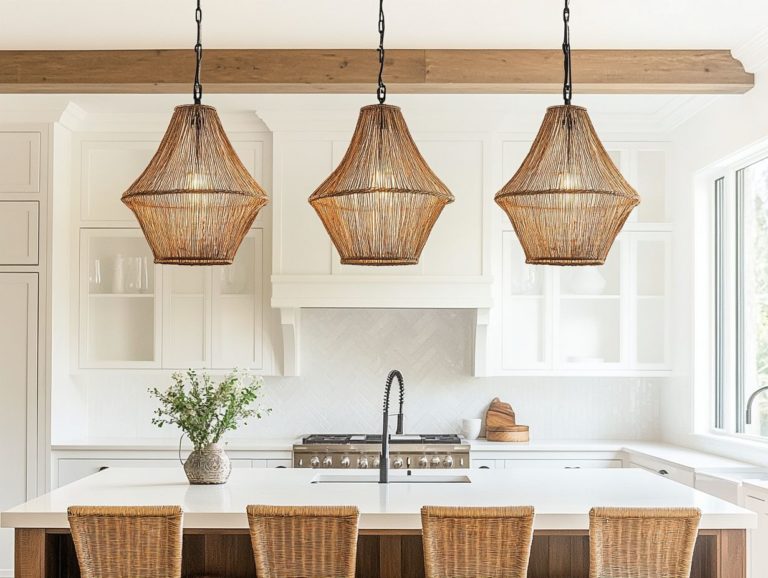Understanding CRI in Kitchen Lighting
Kitchen lighting can transform your space! The Color Rendering Index (CRI) is essential for creating a vibrant and functional kitchen. Understanding CRI elevates your kitchen’s look and enhances visibility, making colors come to life.
This article explains CRI’s definition and significance. You’ll also learn how to choose the ideal CRI for your needs while debunking common myths and sharing tips to improve it.
You will also discover exciting advancements in CRI technology!
Contents
- Key Takeaways:
- What is CRI?
- How CRI Affects Kitchen Lighting
- Choosing the Right CRI for Your Kitchen
- Common Misconceptions About CRI
- Improving CRI in Your Kitchen
- Future of CRI in Kitchen Lighting
- Frequently Asked Questions
- Wondering what CRI means?
- What is considered a good CRI for kitchen lighting?
- Can the type of light bulb affect the CRI in my kitchen?
- Is it necessary to have a high CRI in all areas of my kitchen?
- What are some tips for improving CRI in my kitchen lighting?
- Can I rely on CRI alone when choosing kitchen lighting?
Key Takeaways:

Understand the importance of CRI in kitchen lighting and its impact on color and visibility.
Consider factors like bulb type and color temperature when choosing the right CRI for your kitchen.
Improve CRI by following practical tips and staying informed about innovations.
What is CRI?
The Color Rendering Index (CRI) measures how well a light source shows colors compared to natural sunlight. This metric is crucial for everything from home décor to professional settings.
A higher CRI value means colors appear more vibrant and true to life. This greatly influences visual appeal and overall lighting quality, especially with LEDs or incandescent lights.
Understanding CRI can help you create the perfect ambiance in any space.
Definition and Importance
The CRI serves as a precise measure of a light source’s capability to replicate the colors of various objects accurately. This is especially important when comparing it to natural light, such as daylight.
Originating in the 1960s, CRI has become an essential tool for evaluating lighting quality. It benefits designers, architects, and consumers alike.
This index is calculated on a scale from 0 to 100, where 100 signifies perfect color accuracy. It assesses how effectively a light source displays a spectrum of colors, including skin tones and vibrant reds.
For example, LED lights usually fall within a CRI score of 80 to 90, while high-quality natural light sources often achieve scores nearing 100.
This evaluation holds particular significance for designers aiming to craft visually captivating environments. The choice of lighting can dramatically influence how the colors of furnishings and materials are perceived.
How CRI Affects Kitchen Lighting
CRI is essential in kitchen lighting, significantly enhancing color accuracy. This is crucial for tasks such as food preparation and cooking.
You need to perceive the true colors of ingredients and surfaces clearly for both safety and aesthetic purposes.
A kitchen illuminated with high CRI lighting boosts visual appeal and creates a more inviting atmosphere. It ensures that colors appear true across various lighting fixtures.
Impact on Color and Visibility
The color temperature of your kitchen lighting plays a crucial role in how well you see and perceive colors.
Warmer temperatures tend to enhance skin tones, making them more flattering. Meanwhile, cooler temperatures offer better clarity for those detailed tasks that require precision.
These variations are closely tied to the CRI, which measures how accurately artificial light replicates colors compared to natural light.
A higher CRI value means you’ll enjoy vibrant and true-to-life colors. This is especially important when you’re preparing and presenting food.
LED technology is key in achieving the ideal lighting setup. It provides a broad spectrum of color temperatures and high CRI ratings.
But it’s not just about the type of light; the positioning of your light sources matters too. Poor placement can create shadows that distort color perception and negatively affect your cooking experience.
Therefore, selecting and positioning lighting fixtures thoughtfully is essential for crafting a kitchen that is both functional and visually appealing.
Choosing the Right CRI for Your Kitchen

CRI stands for Color Rendering Index. It measures how accurately a light source displays colors.
Choosing the right CRI for your kitchen involves thoughtful consideration of several factors that impact lighting performance. Consider the types of lighting fixtures, the activities you engage in, and the aesthetic ambiance you wish to create.
Aiming for a CRI of 90 or above is advisable for task lighting. This ensures colors are rendered accurately and naturally, enhancing functionality and energy efficiency.
Factors to Consider
When selecting lighting for your kitchen, consider the CRI rating and other essential factors like energy efficiency and the overall visual appeal.
This interplay can impact how you perform tasks and the ambiance of the area. A high CRI rating, ideally above 90, ensures colors appear vibrant, especially during food preparation and dining.
Bright and accurate lighting can make fresh produce look more appetizing! Choosing energy-efficient fixtures doesn’t require compromising on color accuracy; many LED options today offer excellent CRI values while minimizing energy consumption.
By balancing these considerations, you create an environment that is both functional and inviting.
Common Misconceptions About CRI
Despite its significance, several prevalent misconceptions about CRI can create confusion for consumers and professionals.
These misunderstandings can cloud interpretations of its implications for color rendering and overall lighting quality.
Debunking Myths and Clarifying Facts
One myth is that a higher CRI always guarantees superior lighting quality. While a CRI above 90 is ideal, other factors like color temperature and specific applications are also essential.
For example, lumens measure brightness, while wattage indicates energy consumption. Both are critical when assessing overall lighting effectiveness.
A high CRI light source, like an LED with a CRI of 95, may deliver stunning color rendering. However, if it produces only 300 lumens while consuming 10 watts, it falls short for spaces needing more illumination.
Conversely, a CRI of 80 might not dazzle in color quality but could still provide sufficient brightness with lower energy usage, proving effective for practical applications.
Understanding the relationship between CRI, lumens, and wattage helps you make informed decisions—ensuring your lighting is both functional and aesthetically pleasing.
Improving CRI in Your Kitchen
Enhancing the Color Rendering Index in your kitchen means embracing practical solutions that elevate color accuracy and lighting quality.
This approach can transform your culinary experience and enrich the aesthetic appeal, making cooking and dining enjoyable!
Practical Tips and Solutions

- Boost your kitchen’s CRI with high-quality LED strip lights. They mimic natural sunlight and make colors pop!
- Select renowned brands like Philips or Cree, known for exceptional color rendering capabilities.
- Combine different types of fixtures—like pendant lights and recessed lighting—to create layered illumination.
- This blend improves color clarity while cooking and fosters an inviting atmosphere for gatherings.
Thoughtfully chosen lighting can transform your kitchen from ordinary to vibrant, a space that exudes practicality and style!
Transform your kitchen today and enjoy a vibrant space that’s perfect for cooking and entertaining!
Future of CRI in Kitchen Lighting
The future of Color Rendering Index (CRI) in kitchen lighting is set for remarkable advancements as LED technology continues to evolve.
Lighting design will focus on energy efficiency and better color rendering, ensuring your culinary space is both functional and visually appealing.
Advancements and Innovations
Recent advancements in lighting technology have introduced innovative solutions that enhance CRI and energy efficiency, which are crucial in kitchen lighting where color accuracy is essential.
One standout innovation is tunable white lighting. This feature enables you to adjust the color temperature throughout the day, mimicking natural sunlight. This flexibility elevates the aesthetic appeal of your kitchen and positively influences your mood and productivity while cooking.
Smart controls take this experience further, offering personalized settings accessible through apps or voice commands. For example, products like Philips Hue and Lutron allow you to create customized lighting scenes that beautifully highlight food preparation areas or set a warm, inviting atmosphere for evening gatherings.
These innovations enhance your experience and reshape kitchen design by emphasizing zones that require optimal lighting for both functionality and visual allure.
Frequently Asked Questions
Wondering what CRI means?
CRI stands for Color Rendering Index, which measures how well a light source accurately represents colors compared to natural daylight. In kitchen lighting, CRI is important because it affects how true and vibrant the colors of food, dishes, and countertops appear.
What is considered a good CRI for kitchen lighting?

A CRI of 90 or above is considered excellent for kitchen lighting. While a CRI of 80 is still good, it may not accurately represent certain colors as well as a higher CRI. Aim for a CRI of 90 or above for optimal color accuracy in the kitchen.
Can the type of light bulb affect the CRI in my kitchen?
Yes, the type of light bulb plays a crucial role in your kitchen’s CRI. LED bulbs generally have a higher CRI compared to fluorescent or incandescent bulbs. Choose LED bulbs with a CRI of 90 or above for the best color accuracy in your kitchen.
Is it necessary to have a high CRI in all areas of my kitchen?
While it’s ideal to have a high CRI throughout your kitchen for consistent color accuracy, it’s especially important in task areas such as above the stovetop, sink, and countertops. These areas require good lighting for food preparation and accurate color representation.
What are some tips for improving CRI in my kitchen lighting?
- Choose LED bulbs with a CRI of 90 or above.
- Mix different light sources, such as overhead and under-cabinet lights, to provide various angles and reduce shadows.
- Keep light fixtures clean and replace old bulbs regularly.
Can I rely on CRI alone when choosing kitchen lighting?
While CRI is an important factor when choosing kitchen lighting, it is not the only consideration. You should also consider the color temperature (in Kelvin) and brightness level (in lumens) of the light bulbs to achieve the desired mood and functionality in the kitchen.
Transform your kitchen today! Upgrade your lighting for an improved cooking experience.





